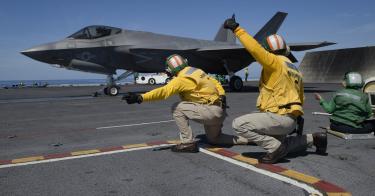The military can celebrate some great news this weekend.
On Friday, President Donald Trump signed the appropriations package that provides funding for the 2019 defense budget, giving the military a much-needed boost.
The non-defense elements of the bill are less welcome, however, and will not serve our country’s overall economic health. The totality of the bill will contribute to our increasing debt and deficit, while not reforming the unsustainable trajectory of federal spending.
The bill also fails to address any conservative policy priorities outside the realm of defense.
Many members of Congress stomached all the shortcomings of the billbecause of the importance of the defense-related elements in the legislation. Most members of Congress understand that the current state of our Armed Forces warrants an increased and timely budget.
Since its inaugural edition in 2015, The Heritage Foundation’s Index of U.S. Military Strength has catalogued the current state of our military, measured against its ability to engage in two simultaneous major wars.
Recent years have been unkind to our Armed Forces, as all four branches have experienced decline in multiple areas, For example, the Air Force is the smallest it has ever been and possesses the oldest planes since it was formed. At the same time, a rising China, an aggressive Russia, a terror-supporting Iran, and a nuclear-armed North Korea all present new and formidable threats to U.S. interests.
Thankfully, because of Trump’s early push to rebuild the military and his partnership with Congress in passing appropriations in 2017 and 2018, we now have some hopeful indications that the tide has begun to turn. For example, readiness among Army brigade combat teams has improved since 2017.
These and other key changes will be discussed when The Heritage Foundation releases the 2019 edition of the Index of U.S. Military Strength on Oct. 4. The keynote speaker, Sen. Joni Ernst, R-Iowa, has long championed a strong and robust military.
The newly passed 2019 defense appropriations bill is an important part of the road to recovery. There are many things to applaud in the bill.
First of all, it was signed before the beginning of the new fiscal year. This means that for the first time since 2010, the Pentagon will not have to deal with the negative effects of operating under a continuing resolution. This rare funding constancy at the start of the fiscal year will allow the services to actually use all 12 months of the year to train and rationally spend the money provided for their use.
The bill also provides military personnel with a well-deserved 2.6 percent pay raise. The raise will help to attract new recruits and retain current service members. This is especially critical in a day when fewer and fewer Americans are eligible to serve and the Army in particular is struggling to meet its recruitment goals.
In addition, the bill will fund the Pentagon to increase its forces by over 24,000. It will also begin the process to increasing the size of the Navy’s fleet, investing over $24 billion in the construction of new ships. It also funds 93 new F-35 combat aircraft—the most capable fighter in the world.
The bill also provides more funding for military hardware and research and development efforts that, if sustained, will be of great help to our military.
Notwithstanding these positives and the military’s recent modest gains in readiness, the United States cannot consider the rebuilding of our military completed.
It took years of over-use and budget cuts for our Armed Forces to deteriorate to the degree that they have. It will therefore take years to reverse the decline in readiness and restore our military to serve the nation’s needs, as our national leaders have described.
Rebuilding our military is not a one-year process, and it will require continued investment and care in the coming years. We cannot and should not consider the job done.
This piece originally appeared in The Daily Signal



